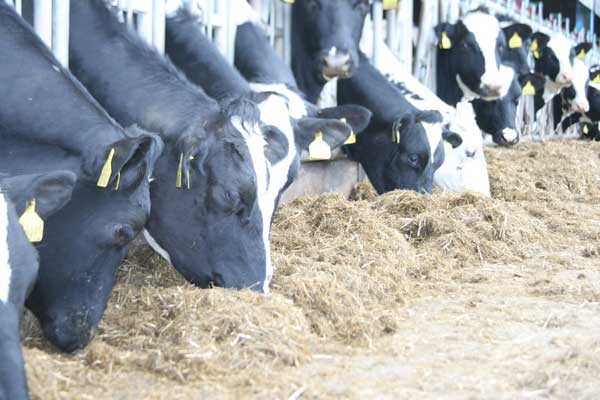
While more dairy cows are now housed at night, even during the summer, dairy farmers should grasp the opportunity to use the TMR mix to make up for any energy shortfalls in day-time grazed grass.
And although grass-driven milk producers may only be feeding small amounts of concentrates, it’s critical to ensure cows are receiving enough sugar in their diet to mop-up excess levels of protein as forage intakes switch from silage to mainly grazed grass.
“Fresh grass is a decent source of sugar and protein but not necessarily enough to meet the needs of high yielding dairy cows. Well-balanced diets should contain 6-7% sugar to maximise rumen function and overall performance,” says Dr Phil Holder of molasses sugar suppliers E D and F Man.
“Dairy farmers shouldn’t assume that the molasses part of their cow diets isn’t needed in the summer. Even cows that are going out to grass during the day and being housed overnight should be fed a TMR mix that includes energy from one of the lower-sugar option molasses feeds.”
Dr Holder says protein intake levels can almost double when cows move from silage to grazed grass and the diet has to provide a mechanism to cope with that.
“And where concentrate levels are being reduced it’s essential not to underestimate the role of sugar to cope with this excess protein.
“Where the emphasis is on grass to produce milk it’s even more important not to lose sight of how much sugar there is in the cake, as well as being aware of the protein and energy levels. The sugar mops up the protein.”
Dr Holder says a high milk urea level will flag up any cows suffering from an excess level of nitrogen – and if the figure is above 250-300 the cow is having to use additional energy to excrete it.
“And dairy farmers must remember that there’s a cost involved in excreting this nitrogen through the liver and into the urine and the milk and the blood – and that cost is energy that needs to be utilised by the cow to produce milk. Maximising sugar intakes over the summer can be achieved through molasses based liquids.”
More compounders are now offering specific feed ranges to complement grass-based systems - and molasses is proving to be the most economical and efficient way of increasing sugar levels in the concentrate. Some feed companies are including molasses at the rate of 9% in their formulations.
Glen Johns of Devon-based compounders Harpers says dairy farmers should be aiming for 6-8% total sugars in the dry matter.
“Making sure there’s enough sugar in the diet at this time of year is important where cows are being grazed by day and kept in at night.
“If they are being given a TMR buffer feed based on maize silage or whole crop plus a little bit of grass silage these cows still need to be getting 1kg of molasses a day in the buffer feed mix.
“Starchy-diets fed as a buffer struggle on sugar levels. Although cows can be eating 30-35 kg of fresh grass every day it’s important to get that extra sugar into them through any buffer feed given at night,” says Glen Johns.
